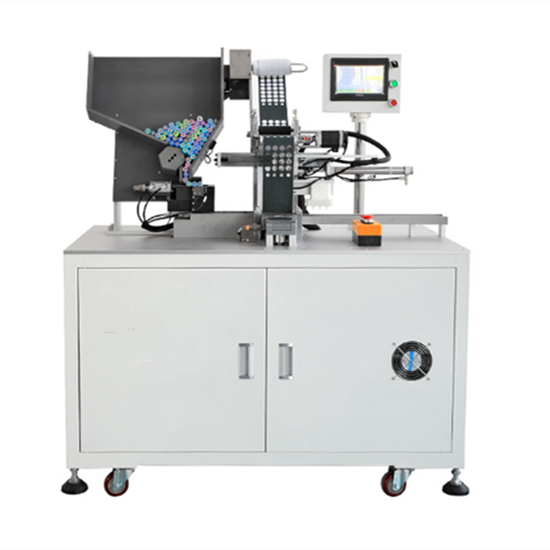Cylindrical Cell Lab Machine: Enabling Precision and Innovation in Battery Research
A cylindrical cell lab machine is a specialized set of equipment designed for the research and development of cylindrical batteries, such as the popular 18650, 21700, and 26650 cells. These machines facilitate precise assembly, testing, and prototyping of cylindrical cells, making them indispensable in battery R&D and small-scale production.
● Key Features of Cylindrical Cell Lab Machines
1. Customizable Design
- Accommodates various cylindrical cell sizes for flexibility in experimentation.
2. High Precision
- Ensures accurate alignment, winding, and assembly processes critical for cell performance.
3. Compact and Modular
- Designed for lab environments, often with modular components to fit different stages of cell development.
4. Automated and Manual Options
- Offers manual, semi-automatic, and fully automatic options depending on research scale and budget.
5. Data Integration
- Includes tools for collecting and analyzing key parameters like voltage, current, and internal resistance.
● Core Components of Cylindrical Cell Lab Machines
1. Electrode Winding Machine
- Rolls anode, cathode, and separator materials into a cylindrical jelly roll with precise tension control.
2. Tab Welding Machine
- Welds electrode tabs (typically made of nickel) to the current collector using ultrasonic or laser technology.
3. Case Insertion Machine
- Inserts the jelly roll into the cylindrical casing (steel or aluminum) with high accuracy.
4. Electrolyte Filling Machine
- Injects liquid electrolyte into the cell with precise volume control to ensure consistent performance.
5. Sealing Machine
- Seals the cell cap hermetically, often using crimping techniques, to maintain cell integrity.
6. Degassing Unit
- Removes gases formed during initial cycling or sealing, ensuring safety and stability.
7. Formation and Testing System
- Cycles the cell for the first charge/discharge, activating the electrochemical materials and testing performance.
8. Safety Inspection Tools
- Includes leakage testing, resistance checks, and visual inspection to ensure product quality.
● Applications of Cylindrical Cell Lab Machines
1. Lithium-Ion Battery Development
- Prototyping and testing new electrode materials for 18650, 21700, and other cylindrical cell formats.
2. Solid-State Batteries
- Developing and testing next-generation cylindrical batteries with solid electrolytes.
3. Battery Chemistry Optimization
- Exploring alternative chemistries such as LiFePO₄, NMC, or silicon anodes.
4. Small-Scale Production
- Producing limited quantities of batteries for niche applications or product pilots.
5. Educational and Institutional Research
- Supporting academic research on energy storage technologies.
6. Quality Control
- Verifying performance and safety parameters for small batches of cells.
● Benefits of Using Cylindrical Cell Assembly machine
1. High Accuracy
- Essential for producing prototype cells with consistent performance metrics.
2. Research Efficiency
- Streamlines the cell assembly process, allowing researchers to focus on material innovations.
3. Cost-Effective R&D
- Facilitates in-house prototyping, reducing reliance on external manufacturing services.
4. Scalability
- Bridges the gap between lab-scale research and pilot production.
5. Safety Assurance
- Integrated safety tests reduce risks associated with battery development.
● Challenges and Solutions
1. Complex Assembly Process
- Challenge: Cylindrical cells require precise alignment and tension control during winding.
- Solution: Use advanced automation and real-time monitoring systems.
2. Material Compatibility
- Challenge: Electrolytes and electrode materials must be carefully matched to avoid performance issues.
- Solution: Machines with flexible parameter settings allow for easy adjustments.
3. Cost of Equipment
- Challenge: High upfront costs can be a barrier for smaller labs.
- Solution: Modular systems offer a more budget-friendly option.
4. Time-Intensive Processes
- Challenge: Multiple steps in cell assembly can slow down R&D.
- Solution: Semi-automated or fully automated machines speed up the workflow.
● Recent Innovations in Cylindrical Cell Lab Machines
1. AI Integration
- Machines with AI algorithms can optimize assembly processes and predict potential defects.
2. Advanced Materials Handling
- Improved capabilities for handling solid electrolytes and high-capacity anode materials like silicon.
3. Multi-Format Compatibility
- Machines capable of working with multiple cylindrical cell sizes and chemistries.
4. Eco-Friendly Processes
- Enhanced systems for recycling and reusing cell components during R&D.
● Future Trends in Cylindrical Cell Technology
1. Higher Energy Densities
- Machines will adapt to handle ultra-thin electrodes and separators for higher energy cells.
2. Solid-State Cylindrical Cells
- Development of tools specifically for the fabrication of solid-state cylindrical batteries.
3. Flexible Automation
- Greater use of robotics and machine learning for adaptive manufacturing.
4. Portable Labs
- Compact, portable lab setups for on-site R&D in remote or distributed locations.
● Conclusion
Cylindrical cell lab machines are crucial for advancing battery technology, providing the precision and control necessary for cutting-edge research and development. From material testing to small-scale production, these machines streamline the fabrication process, enabling breakthroughs in energy storage for applications ranging from consumer electronics to electric vehicles. With continual innovation, cylindrical cell lab machines will remain at the forefront of the energy revolution.

 ru
ru en
en fr
fr de
de es
es pt
pt ko
ko tr
tr pl
pl th
th







 Поддержка сети IPv6
Поддержка сети IPv6